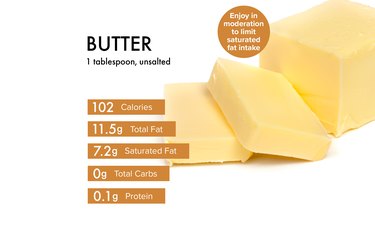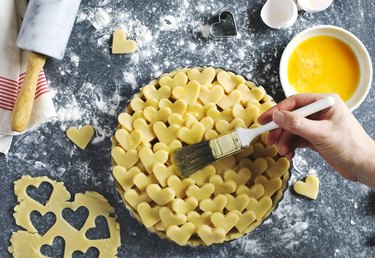
Butter provides flavor, depth and richness to both sweet and savory recipes. While it's high in calories and fat, butter is also a good source of vitamin A and some essential fatty acids.
Technically speaking, butter is a concentrated source of milk fat created from milk, cream or a combo of both that contains at least 80 percent fat in addition to water and nonfat milk solids, according to the National Dairy Council. Traditional butter is made by churning pasteurized cream via batch-process or continuous churns.
Video of the Day
Video of the Day
You may have seen a variety of butter at your local grocery store and wondered what all the different package labels mean. Let's break it down:
- Lightly salted butter: This slightly salty pick is generally labeled sweet cream butter.
- Unsalted butter: This no-salt-added pick is sometimes identified as sweet butter.
- Cultured or European-style butter: This crowd-favorite has a tangy flavor because it is made from cream that has a starter culture to ferment the cream.
- Whipped butter: This is regular butter that has been whipped with air to increase volume.
Unsalted and cultured butter are the preferred types for baking, while salted and whipped butter are best used to spread on toast or baked goods, or to finish dishes.
Butter vs. Margarine: What's the Difference?
There is one major difference between butter and margarine: Butter is made from cow's milk dairy while margarine is derived from plant oils.
Before trans fats were banned, many margarines contained the harmful fat. Nowadays, most margarine brands on the market are free of trans fat yet still caloric like butter, so you'll want to limit them as well, per Harvard Health Publishing.
Butter Nutrition Facts
One tablespoon of unsalted butter is equal to a single serving. One tablespoon of unsalted butter contains:
- Calories: 102
- Total fat: 11.5 g
- Cholesterol:
30.5 mg
- Sodium: 1.6 mg
- Total carbs: 0 g
- Dietary fiber: 0 g
- Sugar: 0 g
- Added sugar: 0 g
- Protein: 0.1 g
Butter Macros
- Total fat: One tablespoon of unsalted butter has 11.5 grams of total fat, which includes 0.4 grams polyunsaturated fat, 3.3 grams monounsaturated fat, 7.2 grams saturated fat and 0 grams trans fat.
- Carbohydrates: A one-tablespoon serving of unsalted butter has 0 grams of carbohydrates, which includes 0 grams of fiber and 0 grams of naturally occurring sugar.
- Protein: One tablespoon of unsalted butter has 0.1 grams of protein.
Vitamins, Minerals and Other Micronutrients
- Vitamin A: 11% of your Daily Value (DV)
- One serving of unsalted butter is not a significant source of vitamin B12 (1% DV), vitamin E (2% DV), vitamin K (1% DV) or any other micronutrients.
Butter vs. Margarine vs. Vegan Butter
Per 1 tablespoon | Unsalted butter | ||
|---|---|---|---|
Calories | 102 | 102 | 90 |
Fat | 11.5 g | 11.5 g | 11 g |
Saturated Fat | 7.2 g | 2.2 g | 8 g |
Carbs | 0 g | 0.1 g | 0 g |
Protein | 0.1 g | 0 g | 0 g |
Health Benefits of Butter
Butter provides some nutrients in a one-tablespoon serving size.
Vitamin A in Butter Can Help Promote Vision Health
Butter is a good source of vitamin A, which is integral to eye health.
Vitamin A is critical to healthy eyesight and helps prevent vision-related issues, including night blindness, according to the National Institutes of Health (NIH).
With 11 percent of our recommended daily value found in only one tablespoon, butter packs a powerful punch.
Butter Health Risks
1. Saturated Fat
Butter, being 80-percent fat, is known to be high in saturated fat, which is linked to an increased risk of heart disease. One tablespoon of butter contains 7.2 grams of saturated fat, which is 36 percent of the recommended daily intake.
If opting to use butter, be sure to use it in small portions to add depth and flavor without overwhelming the food.
2. Food Allergies
Dairy can be linked to either a food allergy or a food intolerance in some people. While these may produce similar symptoms, they are not the same, per Harvard Health Publishing.
Both conditions may lead to feeling gassy, bloated, nauseous or experiencing diarrhea.
So then what's the difference? An allergy to dairy is the body's immune response to the protein found in cow's milk, which is the result of inadequate lactase, the enzyme that breaks down lactose (the natural sugar in cow's milk).
Other symptoms may include hives, cramps, wheezing, vomiting or a rash. An allergy to dairy may be life threatening depending on the severity of the allergic reaction.
3. Drug Interactions
While butter is not known to interact with any medication, be sure to discuss any food interactions with your medical professional.
Can People With Lactose Intolerance Enjoy Butter?
Butter is generally safe for those with lactose intolerance due to its very low, trace amounts of lactose. Cultured butter may contain even less lactose since it starts with fermented cream and is easier to digest.
Butter Preparation and Useful Tips
Butter of all kinds are best stored in the refrigerator or freezer. Unopened, wrapped butter may stay in the freezer for up to nine months or in the refrigerator for two months.
Once opened, it will stay freshest in a covered dish or butter compartment in the refrigerator.
Butter can be stored at room temperature, which helps it remain soft and spreadable for easy usage with toast, pancakes, waffles or other baked goods. But leaving it out for a few days can spoil its flavor, so make sure to use it within a couple days, per the USDA.
However, it is recommended to use a butter keeper ($7.99, Amazon) — an enclosed croc, often ceramic. This keeps the butter fresh for up to one week.
Butter is widely available nationwide at your local grocery store, but it is also a delightful, delicious — and superior — treat that can easily be made at home.

How to Make Homemade Butter
- Buy one pint of high-quality cream or whipping cream.
- Place the cream in a stand mixer or food processor. If using a stand mixer, cover the top with plastic wrap or a kitchen towel to prevent splattering.
- Turn the stand mixer or the food processor to medium-high. Continue until the cream turns solid (butter) and separates from the liquid (buttermilk).
- Pour the buttermilk into a container and save for use in baked goods or in your coffee.
- Pull out the butter and press together into a ball. Wash the butter to remove any remaining liquid by holding it under cold running water. Then, press it to release cloudy buttermilk liquid. Continue a few more times.
- Place butter in a bowl, add salt and mix together to your desired amount.
- Store in a butter keeper, jar or roll into a log with wax or parchment paper. The butter should stay fresh in the refrigerator for up to three weeks or up to six months in the freezer.
Butter can be used in a wide variety of ways. Here are some quick ideas.
- Use in baked goods.
- Swirl into sauces to add richness.
- Use in frosting, aka buttercream.
- Make brown butter by heating butter over medium-high heat until it starts to foam and turn golden. Use as a topping on pasta or vegetables.
- Mix butter with herbs to create a compound butter that can be added to meat, poultry, fish and vegetables.
Butter Alternatives
- National Dairy Council: “Butter”
- My Food Data: “Margarine”
- My Food Data: “Vegan Butter”
- My Food Data: “Unsalted Butter”
- NIH: “Vitamin A Fact Sheet for Health Professionals”
- Harvard Health Publishing: “Living with lactose intolerance”
- USDA: "Is butter safe at room temperature?"
- Harvard Health Publishing: "Butter vs. Margarine"